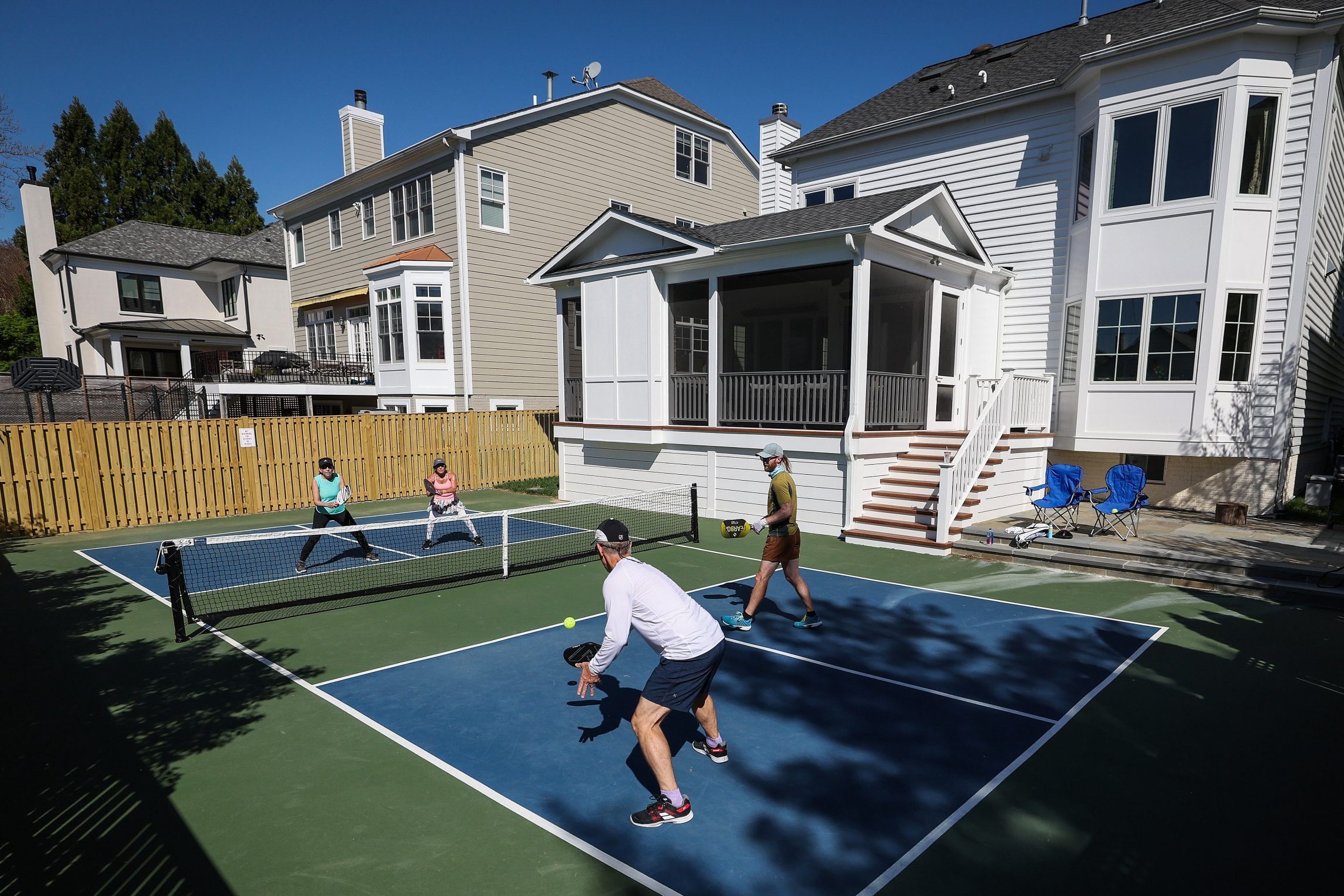Neighborhood pickleball courts packed with players? Make your own pickleball court in no time!

How To Make a DIY Backyard Pickleball Court

Have you caught the pickleball bug yet? Pickleball is the fastest-growing sport in the United States, rising 159% in popularity over the last three years, according to the Sports and Fitness Industry Association.
And why not? It’s fun and easier on the joints than tennis because the court is smaller and the games don’t require as much physical exertion. Plus, it’s great for socializing.
And while many of us play pickleball on modified tennis courts — much to tennis players’ chagrin — you can build your own court if you have the room. So grab a net and a few tools and let’s get started!
On This Page
Choose a Location
A regulation pickleball court measures 44 feet by 20 feet. Besides the actual court, make sure there’s plenty of room to swing and run and serve. USA Pickleball recommends 60- by 30-feet for the entire setup, so you’ll need a pretty good chunk of level real estate. (I planned to build this as I wrote, but my driveway is only 12 feet wide.)
Football stadiums generally face north to south to keep the sun out of players’ eyes. So if you have a choice, orient your court the same way. Pick a surface that’s hard and allows the wiffle-style ball to bounce: Concrete and asphalt outside, and wood, gym flooring or other specialized surfaces indoors.
If you’re just playing for occasional fun and exercise, a large driveway or cul-de-sac works great, according to USA Pickleball. If your driveway is too small for regulation play, like mine, it’s fine to scale down the dimensions for a fun party game.
More serious players can have pickleball courts professionally installed, or excavate and build one themselves out of concrete.
Gather Your Supplies
Here’s what you need to build a DIY pickleball court on an existing surface:
- Two tape measures, one 50-ft. and one 25-ft. (or more);
- Sidewalk chalk for marking the boundary;
- Chalk, chalk dust, painter’s tape or crayons to mark the lines;
- A pickleball net.
Lay Out the Perimeter
Making the outer boundaries of the pickleball court square means thinking back to high school geometry and the Pythagorean theorem. (Don’t worry, you don’t have to do any calculations.)
Start with a straight line for one sideline, then make a baseline at 90 degrees and a diagonal (hypotenuse) to ensure the corner is square. Then we’ll fill in the rest of the boundary with simple straight lines.
- Measure a 44-foot straight line for one sideline. If possible, reference your line against the edge of a concrete seam or driveway edge. Draw a line with chalk along the length of the tape measure and mark the ends with Xs.
- Hold the end of the 25-foot tape measure on one X and measure a little more than 20 feet out at a roughly 90-degree angle. Lock the tape and set it down.
- Hold the end of the 50-foot tape measure on the other sideline X and measure 48 feet and 4 inches diagonally to the 25-foot tape.
- Maneuver the measuring tapes so they intersect at 20 feet and 48 feet, 4 inches. Mark an X in that spot. Draw a straight baseline from X to X with chalk. Do not mark the diagonal.
- Measure a little more than 20 feet out from the sideline X on the other end of the court at a roughly 90-degree angle. Lock the tape and set it down.
- Create the other sideline by measuring 44 feet from the X on the first baseline at a 90-degree angle. When the tapes intersect at 44 feet and 20 feet, mark your final corner and draw in the baseline and sideline.
- Measure the two diagonals to confirm that your court is square. Each diagonal should be 48 feet, 4 inches.
Mark the Lines
Once you have the outer boundary marked with chalk, make the lines bulkier with tape, chalk dust or just draw the lines more prominently with your sidewalk chalk.
If you want, you can buy throw-down vinyl markers. But be aware USA Pickleball says these tend to move around, plus the pickleball doesn’t bounce well on them. Two inches is the standard width for court lines.
To measure and mark the kitchen (the area in front of the net) and the centerline, follow the instructions below.
- Measure 15 feet from each baseline down the sidelines.
- Draw the kitchen line at 15 feet from sideline to sideline.
- Mark the center point of each baseline (10 feet).
- Mark the center point of each kitchen line (10 feet).
- Draw a centerline from the baseline center point to the kitchen line center point. This forms the right and left service courts.
- Make the lines more prominent with tape or chalk, as you did before.
Set the Net
Assemble your portable net according to the directions. Nets are generally held up by metal tubes that fit together when needed and break down into a portable carrying case when not in use. If you’re building a permanent court, set them in concrete.
Place the net in the middle of the court at 22 feet from each baseline and adjust the height. A pickleball net should be 36 inches high at the edges of the court and 34 inches in the center, according to USA Pickleball. When you set up your net, it should stick out on the sides of the court by about a foot.
Play!
Grab a set of pickleball paddles, some balls, a few friends and go play!


















